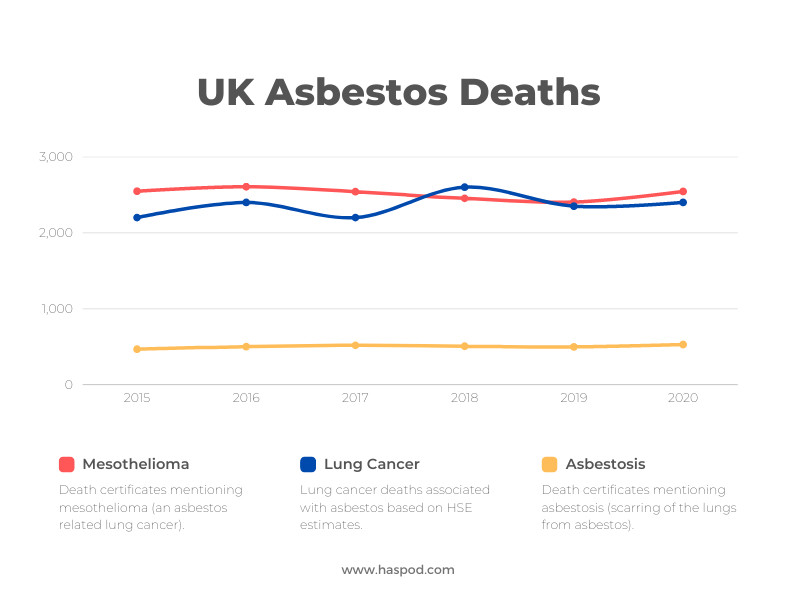19th June, 2024
What Happens To Your Lungs When You Breathe Asbestos
Asbestos is mostly a health risk to your lungs. Breathing in deadly asbestos can cause permanent damage to the inner cells and the outer lining of your lungs and chest wall. How does it get in? And what happens to your lungs when you are exposed? Let's take a look.

Asbestos is the biggest health hazard in UK construction, killing around 5000 people every year in the UK - and that's not about to change any time soon.
Even though asbestos is now banned in the UK, you can still get exposed. And the people who die today were exposed to asbestos years and even decades ago.
In fact, since we last updated this article the number of asbestos-related deaths in the UK has increased.
What does asbestos do to you? Why is it so dangerous?
Knowing why you need to protect yourself against a hazard is one of the most important things to know because it gives you an incentive to avoid it.
Asbestos is mostly a health risk to your lungs - but how does it get in there and what happens to your lungs when you are exposed to asbestos? Let's take a look.
It's all about the fibres
It's not asbestos itself you need to worry about. Well, it is, but what we mean is asbestos isn't something that is going to reach out and harm you. It's not coming after you, and it doesn't spread by itself.
Asbestos is a hidden killer. Asbestos-containing materials can remain in situ within a building or structure and be perfectly safe - as long as they remain untouched and in good condition.
However, with our habit of refurbishing, re-decorating and improving buildings, not many materials can remain untouched for long.
As soon as you drill, cut, saw, knock down or otherwise disturb an asbestos material that has been lying dormant for many years, it releases its fibres into the air.

These asbestos fibres are so light they can stay suspended in the air for days and even weeks!
Asbestos fibres are tiny, strong and sharp. Great properties for building products, creating strong, insulating and fire-resistant materials. Not great for your health.
Asbestos and your body
Asbestos fibres and the human body don't go well together. When released, asbestos fibres mix with the air around you and enter your body when you breathe in those tiny asbestos fibres.
Remember when we mentioned that asbestos fibres and tiny, strong and sharp? Well, it turns out that these properties, while good for construction, are not good for the lungs.

The fibres are so small they are easily inhaled, entering your respiratory system and lungs, and because they are so tiny, they don't get stopped by the hairs and mucus designed to protect you.
The fibres are so sharp, that they hook onto the inner lining of your lungs and chest wall.
And these fibres are so strong, they cannot be broken down by the human body.
Because asbestos fibres are so small and light, they remain suspended in the air for a long time and this increases the risk of exposure to anyone in the area where asbestos has been disturbed.
Asbestos in your lungs
Now we know how asbestos gets into your lungs (by entering your body in the air you breathe), but what happens to your lungs now that you have breathed in those tiny asbestos fibres?
It's not good news I'm afraid.
It can cause debilitating, painful and sometimes fatal conditions, cancers and asbestos-related diseases. Asbestos kills around 5000 people in the UK each year.

Signs of asbestos in your lungs include:
- Cancer
- Lung scarring
- Lung thickening
And even if it doesn't kill you, each of these conditions can make breathing difficult and painful, reducing your quality of life.
Here are some of the main conditions caused by asbestos in your lungs:
Cancers
Lung cancer affects the cells of the lungs, and is almost always fatal, with only a third living beyond a year of diagnosis and only 1 in 20 people surviving beyond 20 years.
Inhaling asbestos fibres can also cause an asbestos-specific cancer called mesothelioma. It's different to lung cancer in that it affects the lining of the surface of the lungs. Asbestos fibres are so tiny and sharp, that they get pulled deeper into lung tissue with every breath.
The outlook for mesothelioma is poor, unfortunately, only 50% live beyond a year, and only one in 10 people live beyond 5 years after diagnosis*. There are currently around 2,500 deaths from mesothelioma each year in the UK.
It is estimated that around the same number of people die from asbestos-related lung cancer each year as from mesothelioma, so we are looking at around another 2,500 deaths each year.
Lung scarring
Asbestosis is a serious long-term lung condition that develops when breathing in the sharp asbestos fibres has scarred your lungs. These scars and the build-up of scar tissue cause symptoms such as shortness of breath, coughing, wheezing and extreme tiredness.
This condition is called Asbestosis.
Unfortunately, there is no cure for asbestosis once it has developed, and the damage to the lungs is permanent and is likely to grow over time.
Because of this damage to the cells in your lungs, you also are at higher risk of developing other serious asbestos-related diseases like lung cancer and mesothelioma.
Lung thickening
Pleural plaques are a fibrous thickening in the lung lining (the pleura). Pleural plaques are almost exclusively caused by exposure to asbestos, so they certainly come under the umbrella of an asbestos-related lung disease.
Pleural plaques are not fatal, but they can make breathing uncomfortable. They can also be a sign that other more serious diseases may develop in the future.
Having pleural plaques doesn't mean you will get other asbestos lung diseases, but the fact you have pleural plaques means you have been exposed to significant quantities of asbestos and therefore lung cancer or mesothelioma may develop.
How long does it take for asbestos to affect you?
People don't get ill the moment they inhale an asbestos fibre. It can take years, often decades, before asbestos-related illnesses develop.
This is one of the reasons why asbestos is known as the hidden killer - because you may not even know when you have been exposed.
The fibres are so small, you can't see them, and you won't instantly feel ill. Days and weeks later, you will still feel healthy.
Why does it take so long to affect you?

When asbestos fibres first enter your lungs, they get hooked in. But they are so small, you won't feel any different. The fibres are so strong they can't be broken down or removed by your body, so they stay trapped in your lungs.
Scar tissue gradually builds up around the asbestos fibres lodged in your lungs, but this thickening and scarring can take many years before it affects you. Over time, tumours can begin to form on the damaged cells.
Most asbestos-related diseases take around 20-30 years to develop following exposure. Although, after heavy and intense asbestos exposure, it could be as quick as 5 years.
The longer you have been exposed, and the higher the number of fibres you have inhaled, the greater the risk to your health.
If you need to refresh your knowledge you can watch a 5-minute toolbox talk on asbestos below.
Need to get your team up to speed on asbestos? Download the free asbestos awareness toolbox talk handout.
*Thanks to the NHS for the survival statistics relating to mesothelioma and lung cancer for this article.
This article was written by Emma at HASpod. Emma has over 10 years experience in health and safety and BSc (Hons) Construction Management. She is NEBOSH qualified and Tech IOSH.
Are You Asbestos Aware?
Take our asbestos awareness elearning course and get your certificate today.
Asbestos Awareness CourseRecent posts like this...

10 Asbestos Awareness Questions And Answers Explained
If you have had, or are about to refresh, your asbestos awareness training, you should be able to answer these 10 asbestos awareness questions. Don't worry if you are not sure about the answers - we explain them in this post to help prepare you for your asbestos awareness training.
Read Post
The Risk Of Asbestos In Artex Ceilings
Many buildings contain artex and other textured coatings on walls and ceilings that may contain asbestos. The biggest risk is not the artex itself, but the potentially deadly fibres contained in it. In this post, we look at when you should be worried, and what the law says about asbestos in artex.
Read Post
The Two Types Of Asbestos Survey (And When You Need Them)
There are two types of asbestos survey, the management asbestos survey, and the refurbishment and demolition asbestos survey. A building may require one type, or both, depending on the use of the building and the work planned.
Read Post